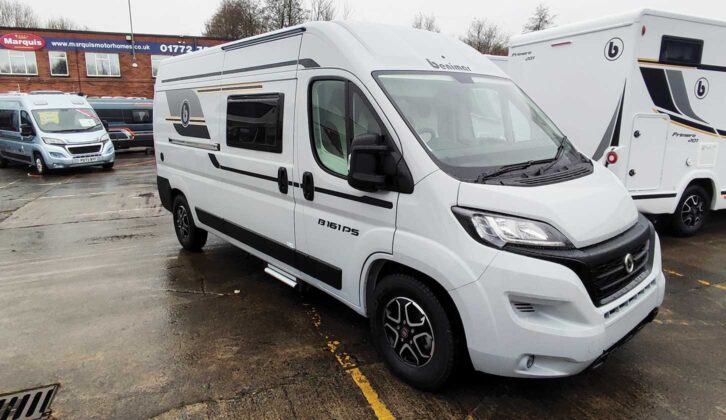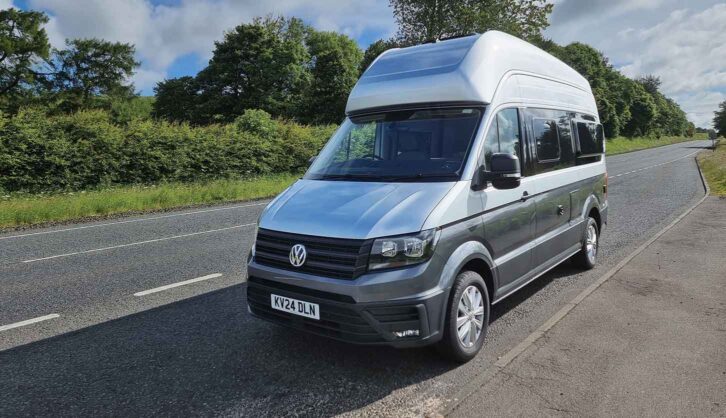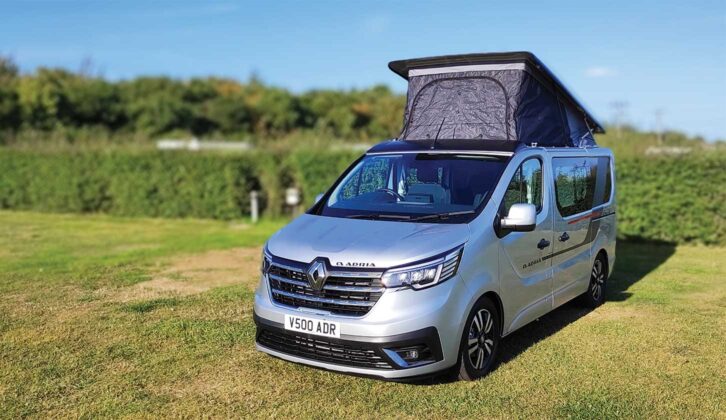The best van for a camper conversion will ensure you have a comfortable base vehicle for making many happy memories. To the uninitiated, the vehicle that your campervan runs on might seem to be of only very limited importance. That’s not perhaps totally surprising: when you first start investigating campervans, you probably want to know more about things like whether the beds are the right size for you, whether the washroom is workable, and how much kitchen storage you have.
But once you start investigating you will soon realise that the base vehicle is enormously important. After all, the whole point about owning the best campervan is the freedom to be on the move for a good part of the time. A good (or not so good) base vehicle can make a huge difference between that movement being a pleasant experience or just a chore. At one end you feel like you have been battling with charabanc for hours, while at the other, you get the best campervans for everyday use, which offer a driving experience so car-like that you can forget you were driving a longer vehicle.
A good van for a camper conversion can make a huge difference to the resale value of your campervan as well. Don’t say it too loudly, but the base vehicle is very possibly the reason why certain campervans seem to stay on dealer forecourts and websites for aeons, while others are gone in an instant, even when they have serious mileage on the clock.
It’s not just something you will research if you’re thinking of getting a van from the best campervan conversion companies or a manufacturer either. The base vehicle you choose can make a huge difference if you ever decide to convert your own van. Light vehicles may look quite similar on the outside, but you soon discover how one has perhaps just a tiny bit more width at the top, which means you can get some extra storage. Another might have a fuselage which is much easier to drill into, so you have more options for where to site important piping and wiring.
Base vehicles are continually being updated, however, particularly now when there is so much more emphasis on sustainability and reducing emissions. Here, we’re talking you through the various options on the market, so you can choose the best van for camper van conversion that will suit you and your needs.
The best vans for camper van conversion:
VW Transporter T7
Ford Transit Custom
Fiat Ducato
Peugeot Boxer
Citroën Relay
VW Crafter
Ford Transit
Mercedes Sprinter
Renault Trafic
MAN TGE
The best van for a camper conversion:

VW Transporter T7
- Length: 5.05/5.45m
- MTPLM: 2800/3025/3225/3350kg
- Engine sizes: 2.0 litre, 110/150/170PS
In the latter half of last year, including during the Motorhome & Caravan Show at the NEC, there was a notable hiatus in all discussions about the VW Transporter. Why? Because the new Transporter T7, the seventh generation of perhaps the most famous campervan vehicle of them all, had just been launched at a commercial vehicle show in VW’s home city of Hanover, so all orders based on the old T6.1, seen on models such as Bilbo’s Celex HL, had effectively ceased.
In January this year, the company said the first panel van versions of the new vehicle will go on sale in the UK in April.
It’s no surprise that there should be such anticipation. After all, the best VW campervans make iconic sights. Is your idea of a campervan something that hippies drove around in the 1960s with a big VW badge on the front? Then you are thinking of the VW Transporter – although the look of the vehicle has changed quite considerably from those early models with split windscreens, louvred windows and bulky roof racks. (If you can still find one in pristine condition, they hold their value remarkably well.)
Over the years the Transporter has worked wonders as a day-to-day vehicle as well as an easy-to-drive campervan, usually with the layout that came to be known as “classic VW” – a back bench seat with two or three seatbelts that flattens out into a bed, with all the furniture and the kitchen down the side, and (usually) a pop-top roof.

The Transporter was usually low enough to fit under most car park barriers too, something which can be an advantage when choosing between a campervan or motorhome, and the new continues this tradition, being just 1.99m high. It is longer than before, however – even the short wheelbase version is over 5m, at 5.05m. That could cause more of a problem with some parking spaces. The long wheelbase version is 5.45m long.
This seventh generation completes a range of three new “Bulli” vehicles VW is launching in this field. This includes the all-electric ID Buzz, which some small converters have started to experiment with turning into a campervan, and the Multivan, designed as a “family and business” vehicle, which VW itself is using to create an updated version of its California van.
But for other converters, attention is still likely to be on the Transporter, which for the first time now comes not just with three different turbo-diesel engine options, but also with a plug-in drive option and three all-electric drives. The largest of the turbodiesel engines, the 170PS, comes as standard with an ex-speed automatic gearbox, while this is an option with 150PS. The two larger engines can also be ordered as with VW’s 4MOTION all-wheel drive. The hybrid model, which will be due out in 2026, comes with a 230PS engine, while the fully electric eTransporter offers 136PS with a 64kWh battery.
There’s more excitement in the cab, too, with more USB sockets, and the option of at least one 230V socket – going up to three in the hybrid and all-electric models.
There is just one thing to note. While VW has gone to some effort to make the front of the van resemble the old T6.1, from the rear it looks strangely like one of its rivals, the Ford Transit Custom. There is a good reason for this – the companies will be working together more closely in the future on light van production. Exactly how closely is still being ironed out.

Ford Transit Custom
- Length: 4.97/5.34m
- MTPLM: 3400kg
- Engine: 2.0-litre, 130/150PS
Yes, the van that seems to be the choice vehicle of solo tradespeople up and down the country is also the one vehicle that has really been giving the VW Transporter a run for its money when it comes to base vehicles since its launch in Europe in 2013.
Converters like it because its slightly more boxy style means you potentially have more room for things like lockers near the ceiling – especially in a high top. Most people also love the Custom’s cab, with its very car-like setting particularly when compared with older Fiat Ducatos. The newest Transit Customs also come with a squarish steering wheel that looks surprisingly like what you might have seen on older computer game consoles.
Many people looking to buy a campervan in this market segment will also be looking to use it as a day-to-day vehicle, and that is also why the Transit Custom’s people mover sister vehicle, the slightly higher spec Tourneo Custom, has also proved popular. It offers the option of adding a second row of seats in the rear, taking the total number of passengers up to seven.
The new Tourneo first rolled off the production line in Ford’s factory at Craiova in October 2023 and more recently has been chosen as the base vehicle for the Panama, the Trigano Group’s campervan brand, which includes the Panama P12 and P57, both of which were winners at the recent Practical Motorhome Awards 2025. Wellhouse Leisure has also produced models based on a Tourneo.

Around the same time the new Tourneo was launched, the Ford plant in Turkey started production of the new all-electric E-Transit Custom, with an output of either 135PS or 217PS and a range of 236 miles. There already is a PHEV version of the Custom that uses the same 2.5-litre petrol and 65kWh engine you will find in a Ford Kuga SUV.
As with Volkswagen, Ford produces its own campervan based on a Transit Custom. The Nugget, built for Ford by Westfalia, now also comes with a PHEV option as well.
The Transit’s future is likely to be tied up more closely with the future of its arch-rival the VW Transporter. The two companies are now working together on producing light commercial vehicles for the future.

Fiat Ducato
- Length: 5.41/5.99/6.36m
- MTPLM: 3500/4250kg
- Engine sizes: 2.2-litre, 140/180bhp
For many years the Ducato had been the undisputed market leader in the motorhome conversion market. That’s a situation that would be puzzling to anyone with experience of the commercial vehicle market, where it is far from leading. But clever distribution negotiations Fiat made with several makes of motorhomes (including Swift) at the end of the last century helped it to build a big lead.
That hegemony looked like being challenged in the immediate aftermath of the pandemic when problems in Fiat’s supply chain led many converters to start looking elsewhere. Not just to the Peugeot Boxer and Citröen Relay – two brands that are part of the same Stellantis Group as Fiat, are made in the same factory, and are largely the same (except for the gearbox). More ‘vans started appearing based on the Ford Transit, the VW Crafter, and even the MAN TGE.
But more recently the pendulum has started to turn back in Fiat’s favour, with more converters returning to the Italian brand. Auto-Sleepers, for example, has switched all its Peugeot Boxer-based vehicles to the Fiat Ducato, after years of relying on Peugeot. Pilote’s entry-level brand Joa Camp, which initially sought to cut costs by running on a Citroën Relay, has already switched to Fiat.

One model that we reviewed that impressed us was the Benimar Benivan 161, where we were impressed by how two lengthway single beds and an impressive washroom were fitted into it, despite a length of only 6m.
Some in the industry think such a return is not entirely surprising, for the simple reason that over the years the Ducato has proved itself to be the easiest van to convert to a campervan. Its square shape makes it easier to work inside, while its relatively clear fuselage (in comparison with other vehicles) makes drilling holes to put in things like water tanks that much easier.
Steering older models of the Ducato used to feel a bit like stirring a witch’s cauldron, but that improved with a new more car-like design to the cab in 2014. And since then the automatic gearbox (something Fiat’s sister brands in Sevel do not offer) has also improved. In 2019 Fiat replaced its old robotised 7-speed Comfort-Matic gearbox with a new fully automatic 9-speed box – more recently changed again to 8-speed.
Further improvements in 2022 mean the vehicle comes with a host of new safety and autonomous driving features.

Peugeot Boxer
- Length: 5.41/5.99/6.36m
- MTPLM: 3300/3500/4005kg
- Engine sizes: 2.2 litre, 120/140/165bhp
The Boxer is the second most popular base vehicle among the Sevel group for UK van converters. In the UK it may have been abandoned this year by Auto-Sleepers, but it still forms the basis for all Elddis models except campervans. On the Continent, it is less popular, although not unknown.
The main difference over the Fiat is that with the Peugeot an automatic gearbox is not really an option. Auto transmission still really has to catch on in Peugeot’s home market of France, so it isn’t offered. As a result, if you choose a motorhome which is usually based on a Peugeot but wants it automatic, you may well find you have to pay extra for a souped-up Fiat engine instead.

Citroën Relay
- Length: 5.41/5.99/6.36m
- MTPLM: 3300/3500/4005kg
- Engine sizes: 2.2-litre, 100/120bhp, and 3.0-litre 160bhp
Known as the Citroën Jumper in Europe, the Relay isn’t as popular an option as a base vehicle in this country, even though motorhomes based on it frequently come out cheaper. Hobby uses the Citroen as a base vehicle for its cheaper ranges, but Pilote’s budget brand Joa, which initially used the Relay on models such as the 2023 Joa Camp 60G has dropped it in favour of the Fiat Ducato. If anything, the Citroën vehicle likely to be getting the most attention this year is its SpaceTourer. That is the model Citroën has chosen to use as the base for the Holidays, its first-ever entry into the campervan market, built for it by Brava Mobil in Slovenia.
VW Crafter
- Length: 5.98/6.84/7.39m
- MTPLM: 3000/3500/5000kg
- Engine: 2.0-litre 140/163/177PS turbodiesel
VW’s larger alternative to the Transporter has been gaining in popularity, particularly in the wake of supply issues at Fiat.
It is of course the base vehicle for VW’s very own Grand California model, such as the VW Grand California 600. But more recently Adria has extended its Compact range to run on Crafters as well, while Hillside Leisure has also been making more Crafter-based models.

The vehicle was updated in the middle of 2024 too, with a widened range of driver assist and safety features including autonomous emergency braking, lane assist, and acoustic park distance control for the rear area, all of which will help to improve the campervan driving experience.
There’s also a new 10.4in infotainment screen, as well as wireless smartphone charging, and a USB-C connection. The steering wheel has also been revised, as have the electronic handbrake switch and optional automatic gearbox controls.
This is the second generation Crafter to be built by Volkswagen itself. Although the vehicle was launched in 2006, for its first ten years it was effectively a rebadged Mercedes Sprinter. Then in 2017 Volkswagen redesigned the vehicle and brought production of it in-house.

Ford Transit
- Length: TBC
- MTPLM: TBC
- Engine: TBC
Some motorhome manufacturers may now be returning to the Fiat Ducato as a base vehicle of choice, but the supply problems coming out of the Sevel factory in recent years have only been good for the Ford Transit. It has gone from being almost an also ran in the base vehicle popularity stakes to a popular contender.
Swift, for example, which started this decade being an all-Fiat converter, now builds its flagship low-profile Voyager on a Ford Transit. And Bailey, having now discontinued its Peugeot Boxer-based Autograph range, is relying entirely on the Transit for both of its low-profile ranges, the Adamos and the Aloras. Both companies have also worked with Ford and used the full Transit as the base vehicle for their latest van conversion ranges, the Trekker for Swift and the Endeavour for Bailey, which includes this year’s winner of the best 2 berth campervan with a shower and toilet at the Practical Motorhome Awards 2025, the B63.

As with its more compact Transit Custom, it’s not difficult to see why the Transit has been such a go-to vehicle. First and foremost it (usually) works out cheaper than the Ducato. It has a more car-like driving position too, although opinions on the snout-like front profile and more spongy gears are more divided.
Last year both the Ford Transit and its all-electric cousin the E-Transit were upgraded with an optional eight-speed automatic gearbox powered by a dial on the dashboard, a lighter chassis with an updated front end and larger 16-inch wheels, and a 12-inch touchscreen in the cab.

Mercedes Sprinter
- Length: 5.93/6.97/7.37m
- MTPLM: 3500/3880/5000kg
- Engine sizes: 2.0-litre, 150/170/190PS
The 3-star badge is still proving a very popular base vehicle for a motorhome – and not just at the very top of the market.
Even if a motorhome with a Mercedes Sprinter base vehicle will still be on average £7000 more expensive than an equivalent van on a Fiat Ducato, converters have still gone for the brand.
This season, for example, Malibu built its first-ever van on a Mercedes Sprinter, albeit with an extension Malibu itself designed to make the van just that little bit longer to fit in with Malibu’s Comfort spec level. The Malibu Genius 641 LE, as it is called, is now also available as a 4X4 mode.

At the same time, Coachman, the last major UK caravan manufacturer to move into making motorhomes, is relying entirely on the Mercedes Sprinter to spearhead its move into the market with its Travelmaster and Travelmaster Sportivo low-profiles and its Travelmaster Imperial A-class.
It’s not just the cachet behind the Mercedes name, however, although that can be a serious attraction for recent retirees looking to spend their lump sum. The Sprinter has an enviable reputation for reliability. And, like Fiat and Ford, Mercedes is known for working directly with manufacturers to make a chassis that suits their needs. Hymer’s SLC chassis, which currently graces its B-Class Modern Comfort (BMC) range, was the result of a two-year collaboration between the two companies.
That said, some feel that the taller-than-average body shape of the Sprinter makes for a less satisfactory driving experience. Older versions of the Sprinter in particular – those produced before 2018 – had a bad reputation for road handling, which is possibly why you tend to see older Sprinter-based vehicles languishing on used dealer forecourts for longer, even at a supposedly bargain price.
The third generation Sprinter, which launched in 2018 and for the first time included a front-wheel drive model in its lineup, has proved more of a hit, particularly the minimalist cab.

Renault Trafic
- Length: 5.08/5.48m
- MTPLM: 3010/3070kg
- Engine: 2.0-litre, 150bhp
The Renault Trafic has never really been a top contender in the van conversion stakes. CMC Reimo still has a Trafic-based model in its line-up, and Hillside Leisure used to produce some. But when Adria finally made its Renault-based Active Duo model available in this country last year, several years after it had been launched in Europe, it impressed our judges enough to be named the best small campervan at the Practical Motorhome Awards 2024. However, it never really caught on and has since been discontinued.

Last year also saw the launch of the Renault Trafic E-Tech, an all-electric vehicle with a range of 186 miles.

MAN TGE
- Length: 5.99/6.84/7.39m
- MTPLM: 3000/3500/5000/5500kg
- Engine sizes: 2.0, 75/103/120/130kW
MAN is mainly known for building trucks and lorries, which explains why the MAN TGE is actually a rebadged Mercedes Sprinter with different spec. The vehicle has started to be used more frequently by some larger manufacturers looking to find alternatives to the Fiat – particularly those whose customers are more likely to be looking for a higher gross weight and possibly four-wheel drive.
Campervan converters have also launched models based on the vehicle. These include WildAx, with its Altair model, and more recently Hillside Leisure, which has produced a version of its Hopton model on MAN TGE.
If you are thinking of converting your own model, be sure to take a look at our guide to the pros and cons of self build campervans first.
How we choose the best vans for camper van conversion
The best vans for camper conversion will offer a safe and reliable setting for touring adventures, as well as impacting features such as the engine size and extras such as the gearbox it comes with. We’re able to pick out the standout options on the market in a couple of ways.
Firstly, we run the Owner Satisfaction Awards, where our readers vote to let us know how they’ve got on with their ‘vans, including the base vehicle and their experience with the converter or the manufacturer. Our 2024 results saw 5,013 readers vote, giving us an in-depth insight into the state of the market and allowing us to pick out the leading converters and the standout vans for converting.
We also run the Practical Motorhome Awards, where our expert judging panel use our combined decades of industry experience to pick out the outstanding options on the market for the upcoming season.
Combine this with the hundreds of real-world reviews of ‘vans that we’ve carried out over the years, and we’re in an authoritative position to compile our best van for camper conversion guide, vehicles that will offer a reliable experience.
What is the most reliable van for camper conversion?
The results of our Owner Satisfaction Awards 2024 saw our readers pick out Volkswagen as the most reliable new van for camper conversion, achieving an impressive score of 91.3% to take the top spot in the Best New Base Vehicle category. This was closely followed by Ford, which scored a highly respectable 90.2% to finish in second place. Mercedes took third place thanks to a total of 89.5%.
However, for those looking for a used van for camper conversion, Mercedes came out on top in the Best Pre-owned Base Vehicle category, achieving a score of 87.1%. Volkswagen took second spot, with a total of 85.8%, while Ford rounded up the top three, scoring 85%.
You can see the full results of the 2024 Owner Satisfaction Awards to see how other base vehicles got on.
If you’ve enjoyed reading this review, why not get the latest news, reviews and features delivered direct to your door or inbox every month. Take advantage of our brilliant Practical Motorhome magazine SUBSCRIBERS’ OFFER and SIGN UP TO OUR NEWSLETTER for regular weekly updates on all things motorhome related.









